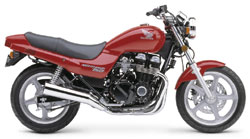Back to Honda Reliable Used Motorcycle Buyers Guide Index Page
Manufacturer: Honda………..TOP Model: CB750SC Nighthawk, CB750 Years Made: 1979-1985, 1991-2003 Present Style: Custom Sport Standard mix Engine Type:
747cc Inline-Four
mm/ “Weight: 475lb HP: 75 Torque: 46 Top Speed: 120mph MPG: 45 New Cost: $ 7,999 (1992) – $9,990 (1996) – $9,990 (1999)
Average Used Costs: Low $2,605 Medium $3,303 High $3,920
Description:
This is the descendant of Honda’s famous in-line four superbike that changed motorcycling forever. It’s designed for everyone who wants performance, but also wants a do-it-all motorcycle. – Honda
Notes:
MR says: 1991+: A lot of effort had been put in by the American Honda market research department to try to determine what type of machine the American public wanted to buy. The overall motorcycle market had been shrinking, and of the remaining sales, Honda’s share had been eaten away by the other manufacturers. The Nighthawk 750 was an attempt to re-kindle the kind of successes the motorcycle market had seen in the glory days of the 1970’s. Honda was prepared to lose money on the Nighthawk, and market the machine at an unbeatable price. Honda raided the parts bins to put the machine together, using the CBX750 engine and styling from the early to mid 80’s Nighthawks. It was meant to be somehow ‘familiar’ to motorcyclists from the late 60’s onwards. Price was to be sub $4000. Maintenance requirements were to be kept to a minimum. Power was to be broad band, with a very linear delivery. The design goals dictated by the focus groups were mostly achieved, but the press seemed to regard it as a bland piece of machinery, albeit at an unbeatable price. The public didn’t come back to motorcycling in the droves Honda expected, and the machine became just another machine in the lineup.
Power peaked at 62.6bhp@8500rpm, with torque of 40.5ft/lb’s@7000rpm. Wet weight was 499lb’s.UMG Says: Retro style complemented by tough, minimal maintenance motor. Motor needs a cylinder head workover and single carb to really shine in this mild form, but runs fine up to 50k when valves a bit suspect. Silly rear disc, suspension competent; handling okay.
IGM Says: (1979-1985) If you’re looking for a good inline four-cylinder Japanese motorcycle, I highly recommend Honda’s original Nighthawk series. In fact, I (and many motorcyclists) prefer them to the newer 750 Nighthawks, simply because they have shaft drives, they are some of the best-handling motorcycles of their day. Some riders take issue with their 16-inch front wheels, which make these bikes seem a bit twitchy in some circumstances, although I’ve found that many novices prefer the maneuverability those same wheels provide.
IGM Says (1991+): While the newer Nighthawk hasn’t won me over quite like the older version, it is still a fantastic all-around motorcycle, and a clean used example represents an even better value than a new one.
IGM Says (1991+) (Best Buy, Best First Bike): Even though this is a fairly large bike, it makes a great motorcycle for new riders. Its combination of balance, stability, and maneuverability makes it much easier to ride than most other 750cc bikes. And because it’s a 750, you can ride it an entire lifetime without outgrowing it. Combine its grace with its low price and easy maintenance, and this bike may be one of the best values in motorcycling.
CMB Says (1984-1986): Hawks made periodic debuts in the Honda line-up. These are great bikes. Honda introduced the CB700SC/CB750SC as an attempt to make the near perfect univeral machine. Do not be fooled. This is a bike designed for chicane (a series of turns). Features include a high concept engine layout tuned for top end performance and an easy to adjust suspension. Low maintenace shaft drive, hydraulic valves and oil-cooling reduce maintenance requirements. For a small bike, it is quite comfortable on long trips. The high 11,000 rpm redline gives you lots of top end speed. Honda dedicated a good deal of research into reducing the height of the engine. Oil is stored in the frame and the generator is located behind the cylinders to reduce engine width (as with the 82 Yamaha XJ650 Seca.)

